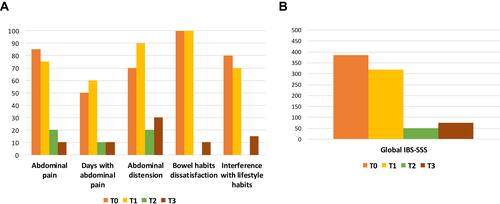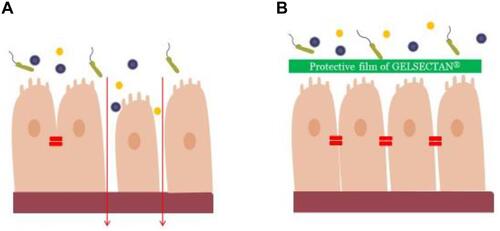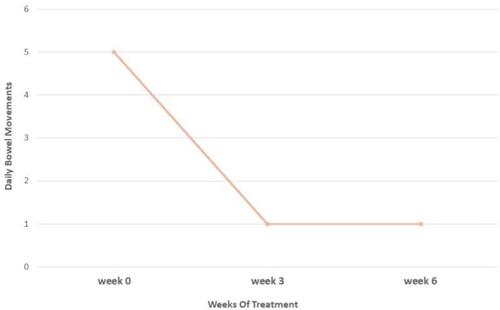Figures & data
Figure 1 IBS-SSS (Irritable Bowel Syndrome Severity Scoring System) single items (A) and global score (B) at T0 (first check-up), at T1 (after six weeks from T0), at T2 (after 12 weeks from T0) and at T3 (after 24 weeks from T0).

Figure 2 Daily bowel movements, Bristol Stool Form Scale (BSFS), and a homemade bowel habits questionnaire at T0 (first check-up), at T1 (after six weeks from T0), at T2 (after 12 weeks from T0) and at T3 (after 24 weeks from T0). Apart from daily bowel movements and BSFS the other parameters were evaluated using a visual analogue scale where 0 was the absence of symptom and 10 was the greatest possible symptom severity.

Figure 3 SF 36 (IQOLA SF 36 Italian version 1.6) for assessing the health-related quality of life at T0 (first check-up), at T1 (after six weeks from T0), at T2 (after 12 weeks from T0) and at T3 (after 24 weeks from T0).

Table 1 Changes After 30 Days of Treatment with GELSECTAN® in Symptoms, Bowel Habits, IBS-SSS, and QoL, Intestinal Permeability
Figure 5 Abdominal pain following treatment with GELSECTAN®. VAS scale from 0 to 10 (0 = No pain and 10 = Worst pain).

Figure 6 Mechanisms of GELSECTAN®in improving intestinal permeability: The intestinal epithelium represents an essential permeable barrier, which regulates nutrient absorption and protects against potential pathogens. Tight junctions (TJs) are multiprotein junctional complexes that form connection adjacent intestinal epithelial cells, and contribute to the intestinal mucosal. In IBS-D, the integrity of the epithelial barrier is impaired (A). The compounds of GELSECTAN® exert important properties in restoring leaky gut (B). The xyloglucan creates a protective film that protects the integrity of mucosal cells against pathogens, allergens and pro-inflammatory compounds. PPT complexes show also a mucoprotective activity. Xylooligosaccharides increase Bifidobacterium and Akkermansia genera in the colon leading to anti-oxidant, anti-allergy or anti-inflammatory activities.


